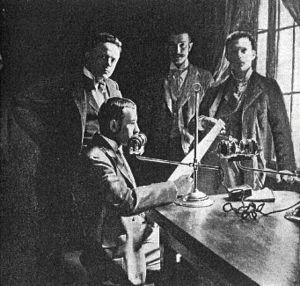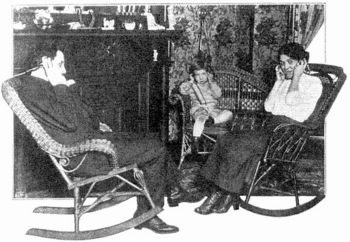Telephone newspaper
Telephone Newspaper is a general term for the telephone-based news and entertainment services which were introduced beginning in the 1890s. These systems were the first examples of electronic broadcasting, and they offered a wide variety of programming, however, only a relative few were ever established. Although these systems predated the invention of radio, beginning in the 1920s they were largely supplanted by radio broadcasting stations, mainly due to the ability of radio signals to cover much wider areas with higher quality audio.
History
After the electric telephone was introduced in the mid-1870s, it was mainly used for personal communication. But the idea of distributing entertainment and news appeared soon thereafter, and many early demonstrations included the transmission of musical concerts. In one particularly advanced example, Clément Ader, at the 1881 Paris Electrical Exhibition, prepared a listening room where participants could hear, in stereo, performances from the Paris Grand Opera. Also, in 1888, Edward Bellamy's influential novel Looking Backward: 2000-1887 foresaw the establishment of entertainment transmitted by telephone lines to individual homes.
The scattered demonstrations were eventually followed by the establishment of more organized services, which were generally called Telephone Newspapers, although all of these systems also included entertainment programming. However, the technical capabilities of the time meant that there were limited means for amplifying and transmitting telephone signals over long distances, so listeners had to wear headphones to receive the programs, and service areas were generally limited to a single city. While some of the systems, including the Telefon Hirmondó, built their own one-way transmission lines, others, including the Electrophone, used standard commercial telephone lines, which allowed subscribers to talk to operators in order to select programming. The Telephone Newspapers drew upon a mixture of outside sources for their programs, including local live theaters and church services, whose programs were picked up by special telephone lines, and then retransmitted to the subscribers. Other programs were transmitted directly from the system's own studios. In later years, retransmitted radio programs were added.
During this era telephones were still considered luxury items, so the subscribers tended to be the wealthy elite of society. Financing was normally done by charging fees, including monthly subscriptions for home users, and, in locations such as hotels, through the use of coin-operated receivers, which provided short periods of listening for a set payment. Some systems also accepted paid advertising.
Individual Systems
Listed below are some examples of Telephone Newspaper systems which were established.
Théâtrophone
The first organized telephone-based entertainment service appears to have been the Théâtrophone, which went into operation in Paris, France in 1890. This system received much of its programming from the Paris theaters, but also reportedly included regular five-minute news summaries. The Théâtrophone ceased operations in 1932.
Telefon Hirmondó
On February 15, 1893, the Telefon Hirmondó — the name was generally translated into English as the "Telephone News-teller" or "Telephone Herald" — began operation in Budapest, Hungary. Its founder, inventor Tivadar Puskás, died just one month after the system went into operation. The system was regulated as a newspaper by the government, with a designated editor-in-chief legally responsible for content. This would become the most prominent and longest-lived of the Telephone Newspaper systems, surviving in a limited fashion until 1944.
At the beginning the Telefon Hirmondó provided a short hourly news program over regular phone lines, however, this was soon expanded into a continuous service over the company's own lines. Its schedule in 1907 was as follows:
A. M. | ||||
| 9:00 | -- | . . | Exact astronomical time. | |
| 9:30 | -- | 10:00 | . . | Reading of programme of Vienna and foreign news and of chief contents of the official press. |
| 10:00 | -- | 10:30 | . . | Local exchange quotations. |
| 10:30 | -- | 11:00 | . . | Chief contents of local daily press. |
| 11:00 | -- | 11:15 | . . | General news and finance. |
| 11:15 | -- | 11:30 | . . | Local, theatrical, and sporting news. |
| 11:30 | -- | 11:45 | . . | Vienna exchange news. |
| 11:45 | -- | 12:00 | . . | Parliamentary, provincial, and foreign news. |
| 12:00 | noon | . . | Exact astronomical time. | |
| P. M. | ||||
| 12:00 | -- | 12:30 | . . | Latest general news, news, parliamentary, court, political, and military. |
| 12:30 | -- | 1:00 | . . | Midday exchange quotations. |
| 1:00 | -- | 2:00 | . . | Repetition of the half-day's most interesting news. |
| 2:00 | -- | 2:30 | . . | Foreign telegrams and latest general news. |
| 2:30 | -- | 3:00 | . . | Parliamentary and local news. |
| 3:00 | -- | 3:15 | . . | Latest exchange reports. |
| 3:15 | -- | 4:00 | . . | Weather, parliamentary, legal, theatrical, fashion and sporting news. |
| 4:00 | -- | 4:30 | . . | Latest exchange reports and general news. |
| 4:30 | -- | 6:30 | . . | Regimental bands. |
| 7:00 | -- | 8:15 | . . | Opera. |
| 8:15 | (or after | the first act of the opera). . Exchange news from New York, Frankfort, Paris, Berlin, London, and other business centers. | ||
| 8:30 | -- | 9:30 | . . | Opera. |
The limited means for amplification meant that the Telefon Hirmondó had to employ strong-voiced "stentors" to speak loudly into double-cased telephones, so that the programs could be heard throughout the system. Although subscribers generally listened on headphones, a loud buzzer, which could be heard throughout a room even when the service was not being actively monitored, was used to draw attention to important transmissions. At its peak, the service had thousands of subscribers, and many contemporary reviews mentioned that the subscription price was quite reasonable.
Electrophone
In 1895, the Electrophone went into service in London, England, working closely with the National Telephone Company. Most of its programming came from live performances via special lines connected to local theaters. On a few special occasions, it also shared programs with the Paris Théâtrophone. The Electrophone ceased operations in 1925, unable to compete with radio. During its thirty years, the service never had more than a few hundred subscribers.
Araldo Telefonico
The operators of the Budapest Telefon Hirmondó were interested in licencing their technology to other sites, and at least two related systems were established. The Araldo Telefonico began operation in Rome, Italy in 1910. In 1922, this system, which at one point had more than 1,000 subscribers, was renamed the Fonogiornale.
Telephone Herald
A second Telefon Hirmondó off-shoot was located in the United States, where the Telephone Herald in Newark, New Jersey (a suburb of New York City) began operation in 1911, but shut down due to economic problems the next year. At the time of its establishment, Manley M. Gilliam served as company president. The Telephone Herald's program service of news and entertainment was closely modeled after the Budapest operation. It also featured original children's stories written by Howard Garis, one of its subscribers, and two collections of these stories were later published in 1912: Three Little Trippertrots, and Three Little Trippertrots on Their Travels.
Additional Reading and Links
Publications
- Marvin, Carolyn, When Old Technologies were New, 1988.
- Povey, Peter J. and Earl, R. A. J., Vintage Telephones of the World, 1998. ("The Electrophone" chapter)
- Sivowitch, Elliot, "Musical Broadcasting in the 19th Century", Audio, June, 1967.
- Solymar, Laszlo, Getting the Message: A History of Communications, 1999.

